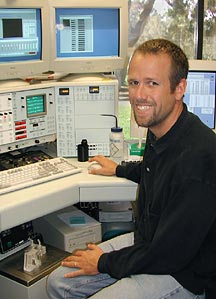Results Flow from Facility
By Mika Ono
Katerina Haraldsson, research associate in the Kono lab,
uses The Scripps Research Institute (TSRI) Flow Cytometry
Core Facility almost every day in the lab's research on the
genetic basis of a lupus-like autoimmune disease.
"In a single sample, we can look for the expansion of different
types of antibodies—T cells, B cells, and subtypes of
B cells—as well as live or dead cells," she says. "I
am absolutely happy with the facility. Alan works to make
the machines what we need them to be."
Alan Saluk, director of the core facility, is enthusiastic
about the power of flow cytometry, a technique that analyzes
cells or particles suspended in a fluid stream.
"Flow cytometry gives researchers a timely way to get a
lot of information," he says. "Scientists can compare samples
or find what percentage of cells show a certain trait. Or
they can separate out a highly purified sample of the type
of cell they are interested in. And the cells come out alive.
There aren't too many methods that can do that."
Flow cytometry, a technique first developed in the 1970s,
typically works using fluorescent probes to bind to specific
cell-associated molecules. As the cells flow past a focused
laser beam, the probes fluoresce and the light emitted is
collected and directed to detectors. These detectors transduce
the light signals into electronic signals, providing a variety
of information, including the relative size and granularity
of a cell, on up to 15,000 cells per second.
The largest facility in the San Diego area with nine instruments,
TSRI's Flow Cytometry Core Faclity runs some 450 analytical
and 70 sorting experiments per month. For those scientists
who choose to run their own experiments, Saluk offers classes
on how to operate the machines. Fifteen to twenty researchers
attend these each month.
"My goal is to make access as easy as possible for those
researchers who want to use the technique themselves," says
Saluk. "I let them push the technology. TSRI is full of brilliant
people. I don't tell them what to do. My job is to facilitate
their research."
On the other end of the spectrum, some scientists are not
at all interested in the technique itself. "For some, [flow
cytometry] is a black box," he says. "That's O.K., too. I'm
happy to provide support so they can focus on other aspects
of their research."
Saluk has been directing the core facility for about a year,
a job he came to after training under Joe Trotter, the facility's
previous director, for two years. Saluk, who has a background
in biochemistry and who worked in industry for several years,
describes the director position as "part biologist, part electrician,
and part plumber."
"I need to understand the data the scientists generate,
guide them in preparing samples, and trouble-shoot research
problems," he notes. "But I also maintain the machines."
Operators Cheryl Silao and Eric O'Connor assist Saluk in
the facility.
Looking ahead, Saluk is committed to keeping the TSRI Flow
Cytometry Core Facility's equipment—and the research
performed there—on the cutting-edge. "I'm keeping my
eye on emergent technologies," he says. "I want our researchers
have the first chance to perform novel experiments when new
technology becomes available."
For more information on the Flow Cytometry Core Facility,
see the facility's web site
or contact Saluk at x4-8251 or e-mail asaluk@scripps.edu.

|

Alan Saluk, director of TSRI's Flow
Cytometry Core Facility, is enthusiastic about the power of
the technique. Photo by Mika Ono.
|

